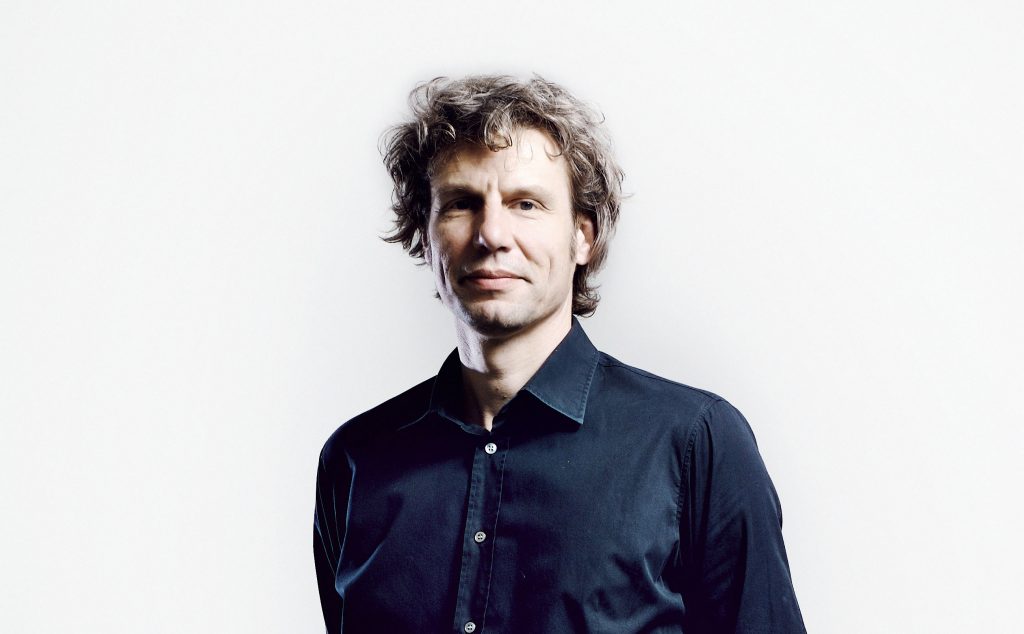Peeling off layers. That’s what Tom Dorresteijn, CEO of the internationally acclaimed Studio Dumbar, does most of his time. Whether it be in the organizations he works for, in the people he works with or in himself – peeling off is the road to purity. The drummer-turned-strategist talks why he never writes more than one page, offering words of wisdom along the way.
Tom, why did you want to be in design? What’s your story?
My story starts in a simple Dutch working class environment. Business life or culture was non-existent. In that respect, my entire journey has been one of wonder and discovery. I started out in communication. It was sheer luck. I didn’t know what to do. I played the drums and I wanted to enter conservatory, but I realized my soul wasn’t spelled out in musical notes. I was clueless. I talked to my dean at school. ‘Are you creative?’, he asked. ‘Well, I play the drums…’. ‘No, with text and stuff,’ he said and he handed me a flyer about a brand new communication course. I couldn’t make much out of it, but I went over anyway. It was a tight selection of more than 300 applicants for 40 places or less. I made it in and to my surprise, I had a great time.
Design came to me when I started working in a communications agency. Back then, I didn’t know a single thing, my education on design had been zero. One day, I overheard a designer and a business journalist talking about a staff magazine, discussing typography and layout. That was the spark – I didn’t have a clue what they talked about, but it was fascinating. My desk was ten feet away from two designers, so I took up the habit of walking over there, asking their opinion on an interesting piece of design that I happened to have found. I always formed my opinion first and tried to figure out what they were thinking. So, little by little, as an autodidact, I started to uncover the field.
When I left the communications agency and went over to the client side, there were new opportunities to get to know the design world a bit better. At that point in time, design felt like a magic forest, it has all sorts of beauty and wonder, but it’s impossible to enter if you don’t know the way. So, I started asking around, see if people in my surroundings knew talented designers or design offices. That led to many suggestions. A whole designer freak show passed by my desk, but in most cases, their portfolio was not convincing. Later I discovered the BNO books, a who’s who of Dutch design. I leafed through them and put up Post-It notes whenever I saw something interesting. At a certain point, I contracted Studio Dumbar for an identity change. We clicked and when I started to work independently, I got on board as a freelance advisor and pitcher. Later, when Gert Dumbar left the studio, I became a partner and managing director.
In your position, is the lack of formal training an advantage or not?
I’ve kept asking myself whether I’m jealous of designers. In the end, I think I’m not. It’s definitely an advantage to bring other things into a project. I’m an analyst with the heart of a designer. To achieve something worthwhile in design, it’s crucial to put together different skills and talents. You can be the world’s greatest designer, but some cases require 96% of strategy and process management to enable something exceptional to happen.
When did you discover that managing this process was a role cut out for you?
It came gradually. My background is in brands and in communication. Over the years, I got my head around the more complex assignments. I discovered I am good at reading organizations and reading people. Ultimately, you try to figure out people. What makes them tick? And how does that relate to the organization and the culture they work in? Reading into all this became my specialization. I try to understand organizations and people. People, not paper. Briefings and strategy are just a form of equilibrium of the opinions in a company, to which everybody subscribes. That’s rational. If you can catch the spirit in the heart of the analysis, right at the start, going beyond standardized strategic models and formats, there’s room for exceptional design.
Can you give us an example of such a process?
Well, Alzheimer Nederland is a good example. We were faced with a tough challenge. This is an organization centred exclusively around one thing: to make the life of Alzheimer patients and their environment easier. Thousands of volunteers put their hearts and souls into it. But you need scientific research to really tackle the Alzheimer problem. Research is expensive, so funding becomes crucial. Making matters worse: their style and visual branding was grey and dreary. Raising funds with uninviting material is impossible. So our style had to put them on the map, fundraising competition is strong.
There are a lot of emotions involved in Alzheimer. Dreary or not, the identity had always been part of people’s bond within the Alzheimer Foundation. And all they think about is the disease, not the design. You have to consider people’s sensitivities. If you don’t, there will be discussions: why spend money on design? If these discussions break out in the media, you’re going backwards, not forward, everything explodes in your face. So there, it was extremely important to read the feelings right. We wanted to introduce something relevant, something not rationally explicable. You don’t need to explain something well. That never works. You need to address the hearts of people. The fastest way to the head is through the heart. The heart is the most powerful communication channel. It’s also the channel where design sits. Good design speaks to the heart.
Could you tell us something about the heart of studio Dumbar? Is there a style?
We don’t have a design-style, but there are unique features. We all strive for purity and simplicity. We all peel off layers and get to the core of things. If you can come up with a design solution at that level, you strike a powerful chord. In the Alzheimer case, we went through an amazing creative process. Tables and walls full of outstanding design, but with every new round, we had to conclude the work was not right. Time and time again: “Great! But not right.” It went on and on. We really showed character there. Not restricted by budgets, we just keep going until we feel the work is done right.
That’s an interesting point. When do you know something is right? Is that a rational thing? An emotional?
It’s an emotional thing you can rationalize. Something intuitive you can explain in words. When I write a debrief, I want to get to the essence of the organization in less than one A4. That’s another form of purity. I could write twenty pages, but that’s easy, you can always talk things together. And then you don’t need to make choices. If you really want to peel down and go to the essence, if you go for purity, it needs to be all over the process, content and everything.
So you act like a watchdog of purity within the studio?
No, we’re all watchdogs at Studio Dumbar. That’s something we share. We’re doing things a certain way, reinforcing each other, often without knowing why we’re doing what we do. It’s deeply rooted in our systems. And everybody contributes. You notice it in when we recruit. We pick people who’re not afraid to be who they are. Whether you’re half crazy or accountant-like, it doesn’t matter, as long as you are who you are, you’re going to find your way at the studio.
How much of yourself do you put in your work?
All of it. There’s no line between who I am and what I do, on the contrary. Designers don’t wear suits, a cliché, but if they want to, they should be able to do so. Earlier in my career, I wore suits to the office. Not because I wanted to, more because I felt I was expected to play a certain role. But that is a waste of time and talent because the only thing that matters is your personality. If you have an ambition, it’s very typical to use force, as if you’re pulling your muscles together. I’m convinced it works the other way round. You don’t need force, you need to peel off layers. Find out what you’re really good at, find out what doesn’t work for you. At Studio Dumbar we’re going to ask what you’re really bad at, so we never have to bother you with it again. It’s a waste of energy on both accounts. We help people discover the warmest source of their talent. If you’re willing to make that journey and admit you’re bad at some things, even if they seem important, you don’t need force. You might have to work hard, but effortlessly, unforced. Peel off and you will touch upon the greatest source of intellect and creativity.
What if people discover their talent is elsewhere?
Well, some of our project managers have a design background. They’re drawn to design and they know how a designer’s mind works. Order and structure is their strength, so they make brilliant project managers. But originally, they’re people who went to art academy, started working and then found out they’re love for design wasn’t big enough. It takes a lot of courage to admit such a thing. If you’re fresh from art academy, with this ideal of your future in the design industry, it takes courage to reach such insights and draw conclusions. Often people don’t.
Is the process of creating something pure also fallible?
Rarely, but yes. The business needs to be thriving and you have to make sharp decisions to make it work. That’s finances and they matter, but our primary concern is the production signing off somewhere between an 8 and a 10. We all have that drive for excellence. It doesn’t mean we’ll make it. Sometimes you just have a professional job to do and it doesn’t allow for an 8 out of ten. Sometimes the process isn’t running as smoothly as you’d hoped for. Sometimes it goes wrong on the client’s side, sometimes on our part. It might be a wrong combination of characters or it might be that the designer’s is having personal issues that resonate in the work.
That, of course, is the shadow side of putting in some much of your personality into your work.
Exactly. But if this work could be done by machines, you wouldn’t have these great peaks of groundbreaking design.

